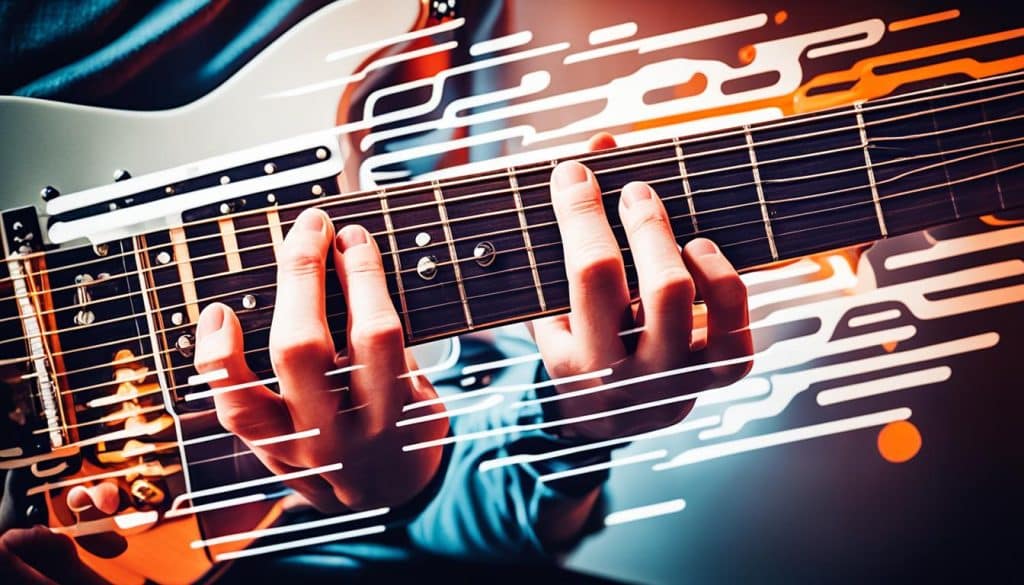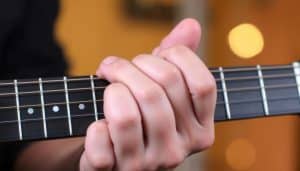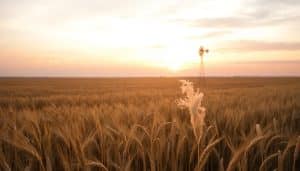Did you know the B Major chord shows up in many popular tunes? Songs like “American Woman” by The Guess Who and “Little Red Wagon” by Miranda Lambert feature it. Yet, it’s tough for newbies due to its barre chord style and the strength needed in your fingers1. Yet, with some good tips and practice, mastering the B chord isn’t as hard as it seems.
Key Takeaways
- The B Major chord is known for its complexity but is featured in numerous hit songs1.
- Understanding the B major chord guitar finger position is crucial for mastering it.
- There are common problems, such as lack of open strings and finger strength requirements1.
- Employing alternative versions of the chord makes it easier for beginners.
- Consistent practice and using effective techniques can simplify learning this chord.
Introduction to the B Chord Guitar
The B chord on the guitar is key for many songs across different styles. Its complexity and the need for technical accuracy make it challenging. Getting good at the B chord by following a detailed b chord guitar tutorial is vital for improving your guitar skills and musical knowledge.
Why the B Chord is Challenging
The B chord is tough for beginners to master2. You need strong fingers and exact placement to play it right, which can be hard for newcomers. Since it doesn’t use open strings, the B chord is harder to play smoothly3. But once you learn it, you can play many more songs, making it a key skill.
Importance of Learning the B Chord
Spending time on learning the B chord is crucial for guitarists wanting to get better. Easier versions like B7 or Bm11 can help you start. They let you work on your finger skills and accuracy2. With around 10-15 hours of practice, moving to the B7 chord becomes easier2. Knowing this chord means you can play a wider range of music, enhancing your guitar playing and enjoyment.
Understanding the B Chord Structure
The B Major chord is crucial for guitarists. It is made of three notes: B, D#, and F#. These create the chord’s foundation4.
Triads, which are three-note chords, are very basic. They help guitarists write music and understand chord relationships4. By knowing the B chord, players can explore the fretboard better.
Learning the B chord structure lets you try different variations. This brings new sounds into your music. Understanding chord theory is vital for improving4.
For beginners, the key of B is not as common due to limited open chords5. Using a capo on the 2nd fret makes it easier, letting you play A family chords in the key of B5.
Chords are made by picking notes from the major scale. Major chords sound happy, while minor chords are sadder4. This knowledge is a great foundation for playing different music styles.
Understanding chord theory helps in playing better solos. It makes your music more expressive. A good theory base encourages you to keep improving on the guitar4.
Common Problems with B Chord Guitar
Learning the B chord on guitar is tricky for many. This mainly happens because it lacks absence of open strings, which usually make chords easier to play. Without open strings, you must press all the strings firmly, making it hard to get a clear sound.
Lack of Open Strings
Since there are no open strings, every finger must be placed perfectly to avoid buzzing sounds. The B chord requires holding down several strings at once. This needs precision and skill. Many guitar brands like Ibanez, Epiphone, and Yamaha are often mentioned when discussing buzzing problems. This is because of uneven frets or not setting up the guitar right6.
Finger Strength Requirements
The position of your fingers for the B major chord also demands strong fingers. Keeping pressure on all strings is vital for a clean note. Beginners usually struggle with this. They are often advised to do exercises to strengthen their fingers before mastering this chord7. Buzzing might also happen if the guitar neck is not straight or some frets are higher. These issues may need fixing by a professional guitar technician6.
How to Play the B Chord on Guitar: Basic Technique
Learning the B chord on the guitar is tough for starters, yet it’s crucial. The technique involves using your index finger to bar strings. You also need to place other fingers properly for the chord’s sound8. Start by putting your index across the second fret. Then, your ring finger goes on the D string’s fourth fret, and your pinky on the G string’s fourth fret. This is how you form the E-shape B major barre chord8.
For beginners, the B chord guitar tab can make learning finger spots easier. The hard part is pressing the index finger hard enough to prevent buzz9. Regular practice will make your fingers and hands stronger, helping with clarity.
The B chord has several ways to play it, adding versatility. For instance, the A-shape B major and B minor 7 chord are different forms8. Each variation fits differently into songs, offering options for guitarists.
If you’re new to guitar playing, try starting with easy B chords. These require simpler finger moves, making the learning curve smoother9. Moving between chord shapes, you’ll see how the B chord adapts. It can change into C and D chords through different positions9.
Three Simple Forms of the B Chord
Learning the B chord can be a challenge for guitarists. Breaking it down into simpler forms can make it easier. We’ll explore three accessible versions of the B chord to help your guitar journey.
Form #1: Beginner-Friendly B Chord
The first B chord form is beginner-friendly. It doesn’t need a bar, which is less scary for new players. You can get to know the chord’s basics slowly with this form. It gives you the B chord’s essential sound without needing a lot of finger strength. This makes it perfect for new players10.
Form #2: Full-Sounding B Chord
The second B chord form is a barre chord that offers a fuller sound. Great for those okay with barre techniques, it promises a richer chord experience. By putting the root note on the fifth string’s second fret, you get a strong and lovely sound11.
Form #3: Quick Transition B Chord
The third form is all about easy transitions. It’s best for more practiced players. Very handy on electric guitars, it supports swift chord changes and smooth playing. Ideal for fingerstyle or when quickly moving between chords1011.
| Form | Difficulty Level | Features |
|---|---|---|
| Beginner-Friendly B Chord | Easy | No bar, essential sound |
| Full-Sounding B Chord | Moderate | Barre chord, fuller sound |
| Quick Transition B Chord | Advanced | Fast transitions, electric guitar-friendly |
Experimenting with these three forms helps you find what works best for you. Whether you’re at the start of your guitar path or further along, mastering these forms makes the B chord easier and fun to play.
B Chord Guitar Finger Position Explained
Getting the B major chord right on a guitar is tough for starters. It’s tricky because it requires flattening the first and third fingers across strings.
You need to press the 2nd, 3rd, and 4th strings at the 4th fret with your third finger12. At the same time, lay your first finger flat across the 1st to 5th strings at the 2nd fret12. This makes sure all strings sound clear, avoiding any unwanted buzz.
The B major chord is often the beginner’s first experience with an “A-shape” barre chord12. Getting it right means you can easily play other chords by moving the same finger shape.
Once you master the B barre chord, you’ll find it’s key to many music styles and songs in D and G13. Its major third note, D#, gives a richer and fuller sound, sitting four half-steps above B14.
Tips for Mastering the B Barre Chord
Learning the B Barre Chord is a big step for guitar players. It opens up new music possibilities. Focus on placing your fingers just right. This greatly improves your abilities with the B chord guitar tab. Regular practice builds the strength and flexibility needed for this chord.
Proper Finger Placement
Getting the B barre chord guitar to sound clear and full depends on where your fingers are. Make sure your index finger is evenly pressing across all the strings. This helps every note sound clearly. It works best to use the side of your index finger to press down15.
Placing your finger near the fret reduces buzzing sounds16. The right thumb position is crucial for the necessary pressure for the barre16. With regular practice, these hand positions become easier. Then, moving to B chord guitar beginner strumming feels smoother.
Reducing String Buzz
String buzz is common but fixable when playing the B chord guitar tab. Start by making your index finger straight. Adjust it as needed to avoid muting strings15. Daily practice is important to get stronger and more flexible16.
Keep your elbow close to your body. Your index finger should be near the fret to lessen buzz15. These efforts make playing the B barre chord easier and fun over time.
Begin with simpler barre chords. Slowly move to harder ones like the B major. This builds your confidence and skill15. Following these tips makes mastering the B chord guitar beginner methods easier. It improves your practice and play.
B Chord Variations for Different Styles
The b chord on a guitar has many versions. These let guitarists use it in many types of music. Depending on the genre and style, you can pick the best way to play it.
Alternate Versions Without Barre
If you don’t want to use a barre for the B chord, there are easy options. You can play partial chords or use fewer strings. For example, you can press the A string at the 2nd fret for a simple open version17. Or, make a mini-barre on the 4th fret across the D, G, and B strings17. This way, you play fewer strings, making it great for beginners.
3-Note B Chord Versions
The 3-note B chords are simpler, fitting well in music that uses less complex chords. A well-liked 3-note chord is the B Power Chord, at the E string’s 7th fret17. It’s great for rock and punk music that needs a strong sound. Another good method is mixing barre chord notes with open strings, like adding the open B string17. These variations make playing easier. They’re excellent for fast songs and quick chord changes.
| Chord Variation | Description | Use Case |
|---|---|---|
| B Major (Rooted at 2nd fret) | Traditional B major chord, commonly used in many genres | General use |
| B Power Chord (Rooted at 7th fret) | Simple, powerful version using three notes | Rock, punk |
| B Major Mini-Barre (4th fret) | Mini-barre across D, G, B strings | Alternative/easy versions |
Effective Practice Techniques for B Chord Guitar
Learning the B chord on guitar needs focus on exercises to strengthen and make your fingers nimble. One in five people find the F-chord hard, especially getting a clear sound on the B string18. That’s why the B chord is also tricky. It’s key to practice regularly and keep a log of your progress18.
It’s important to practice moving between the B chord and others like A and E. This helps you change chords smoothly. Using a metronome can improve your timing and confidence with chord changes. Two people said regular practice is vital for mastering barre chords18. Also, placing your fingers right and not gripping too hard are key for playing the B chord well18.
Adjusting your guitar’s action might make playing barre chords easier. Two users said a good setup helps a lot18. If you’re finding it tough, try the A barre chord at the 5th fret as an easier option18. Changing how you hold your guitar can also solve fingering issues, making playing chords smoother18.
Exploring triads, or 3-note chords, helps simplify finger movements and deepen your chord knowledge19. Two people mentioned it’s crucial to understand how moving barre chords up the neck changes the chords18. This insight is especially helpful during chord transitions and solos.
Adding these tips to your B chord practice will make your approach complete. Repeating exercises to strengthen your fingers works well for improving with barre chords18. Using these practice methods, you’ll get better at playing the B chord.
| Practice Technique | Benefits | Additional Notes |
|---|---|---|
| Consistent practice with a learning log | Track progress and identify areas of improvement | Recommended by 2 users18 |
| Using a metronome | Develops rhythmic accuracy | Helps build confidence in chord changes |
| Proper finger and grip positioning | Essential for effective barre chord playing | Guidance provided by 2 users18 |
| Adjusting guitar action | Facilitates easier chord playing | Advised by 2 users18 |
| Exploring triads | Simplifies complex fingerings | Triads are 3-note chords19 |
Transitioning Between B Chord and Other Chords
Moving smoothly between the B chord and chords like E and A is key for playing a lot of songs. It might take days to get used to new chord forms as you practice these shifts20. It’s important to aim for clean and quick moves to get better at playing smoothly20.
Practicing with a metronome can help make your timing and speed better20.
Practicing with E Chord
With the E chord, start by keeping one finger in place to make it easier. This approach helps when moving between B5 and E5 chords, which you’ll play a lot21. Moving your fingers just right can cut down on unwanted noise and make you more accurate21.
Practicing in short, 5-10 minute periods keeps you focused and stops you from getting upset20.

Practicing with A Chord
Like with the E chord, going to the A chord from B uses special moves. Starting with a finger set in place makes it less hard at first20. Guide fingers help make shifting chords smoother and quieter21. Work on hard changes, like B5 to A5, to get better at guitar shifting20.
Picture where your fingers go even when you’re not holding a guitar to improve20.
Getting good at moving between the B chord and others will broaden the songs you can play. Using varied finger spots, a metronome, and short practice times will make you better at chord changes.
Common Songs Featuring the B Chord
Playing popular songs on your guitar can make learning the B chord fun. These tunes help you get to know the chord. They also make your practice more enjoyable.
“American Woman” by The Guess Who
“American Woman” by The Guess Who is a rock classic. It uses the B chord a lot. This song is great for beginners and those who know a bit about the B chord. It’s known for its unique rhythm and strong sound.
“Little Red Wagon” by Miranda Lambert
“Little Red Wagon” by Miranda Lambert is another great track with the B chord. It’s perfect for those new to the guitar. The song shows how the B chord works in country music. You learn about the chord’s flexibility and why it’s essential to master it.
Songs like these use bar chord shapes, which are useful to know. Bar chords come in four main shapes: E-shape, A-shape, Em-shape, and Am shape. You can move these shapes up and down the guitar neck. This changes the chord’s name22. Playing these songs helps you get better with the B chord and others23.
Reading B Chord Diagrams
Learning the b chord guitar tab means you need to read chord diagrams well. These diagrams help guitar players of all levels see how to place their fingers on the strings. They show six vertical lines for the strings and five horizontal ones for the frets24.
In these diagrams, each finger has a number: index (1), middle (2), ring (3), and pinky (4)25. You’ll see dots and other marks showing where to press down. For example, an “X” means don’t play that string25.
Understanding a b chord guitar tab also means knowing about fret numbers, like “6fr.”25 This tells you where to start the chord, often above the fifth fret. It’s really handy when you’re learning barre chords and their movable shapes24.
Getting to know the B chord in its many forms is key to your learning26. Whether it’s B Major, B Minor, or B7, knowing their diagrams is a must. Plus, these diagrams teach important fretting and strumming techniques26.
Beginner Mistakes to Avoid with B Chord Guitar
Learning the B chord on guitar is tough for beginners. Avoiding simple errors can make a big difference in how fast you learn. We’ll look at two main mistakes: not practicing enough and placing fingers incorrectly.
Not Enough Practice
One big error is not practicing regularly. To get better at the B chord, you must practice a lot. Research shows that only half of the guitar players practice consistently27. If you don’t practice enough, learning chords becomes tougher. Practicing often helps you remember how to move your fingers without thinking.
Incorrect Finger Placement
Placing your fingers wrong can also be a big problem. It can make the chord sound bad or cause a buzzing noise. It’s crucial to put your fingers close to the frets and press the strings firmly. This way, your chords will sound better, and you’ll feel less frustrated.
Why You Shouldn’t Avoid the B Chord
Learning the guitar is full of challenges. One major milestone is mastering the B chord. It might seem tough, but skipping it limits your song choices and growth on the guitar. Getting the b major chord guitar finger position right is key28.
For many, the B chord is hard because it has no open strings and needs strong fingers. If you play electric guitar, try using thicker strings to avoid tune problems. For instance, switch from .010 – .046 strings to .012s for better B chord sound28.
Also, keep your hand positioned correctly and don’t press the strings sideways too much. This can make playing the B chord much easier28.
The B chord shows up a lot in different music styles. It’s in key progressions, like the 6-4-1-5 in D major. You’ve heard it in songs like “Africa” by Toto and “Peace of Mind” by Boston29. Knowing this chord means you can play many more complex tunes.
A big part of the songs you’ll want to play need barre chords and a capo. About 26.31% of songs use barre chords. Avoiding the B chord means you’re missing a lot of popular music30. Learning the B chord opens up a wider range of music and boosts your guitar skills.
To get better, practice b chord guitar variations regularly. It’ll make moving your fingers easier and you’ll get used to different styles. Facing this challenge head-on is rewarding. It’s a key step to becoming a skilled and versatile guitarist.
Advanced Techniques Involving the B Chord
Learning the B chord changes how you play guitar. With it, you can dive into advanced playing styles. It lets you play solos better and fit into different music types.
B Chord in Soloing
Using the B chord in solos opens new sounds. You can use hammer-ons and slides to smooth out your music. Hammer-ons make chords lively, and slides connect them nicely31. Pairing the B chord with scales like pentatonic makes your solos stand out31. Vibratos bring emotion to your playing, making it touch hearts31.
Incorporating B Chord in Different Genres
The B chord fits many music styles, widening what you can play. In rock, the B barre chord gives a solid sound. For R&B, adding thumb slaps and double stops makes chords pop31. And using chords like the 9th in jazz adds complexity31.
Guitar pros try different B chord forms for each song. The E shape of the Bb chord offers unique sounds32. Playing Bb with power chords gives you options32. This versatility means the B chord can fit in jazz or rock.
Keep learning these advanced moves to use the B chord in new ways. It will make your music more interesting, no matter the style.
Conclusion
Learning the B chord on guitar can feel tough but is very rewarding. It’s key for guitarists who want to get better. This guide showed you different parts of the B chord, like where to put your fingers and how to practice. Keep working hard, and you’ll be able to use the B chord in your music easily.
The B chord is more than just a challenge. It opens up new ways to express yourself with music. You might use it in songs like “American Woman” by The Guess Who, or when trying out new music styles. The main thing is to keep practicing the right way. Then, you’ll get really good at playing the B chord on guitar.
For better learning, think about taking structured lessons333435. These can really help you understand how chords change in different songs and styles. Programs like Guitar Chord Bootcamp go into detail on many chords, from simple to complex. To find more help and maybe take lessons, check out this detailed guide. Knowing the B chord well will improve your guitar playing, making it easier to play in various keys and styles.






